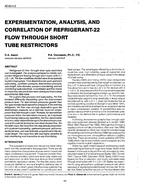One of the benefits of numerical acoustics is that experiments that require special facilitiesand equipment, and long setup times can be simulated on the computer. This is certainlythe case for assessing the attenuation of lined HVAC ducts for a number of reasons. (1)Measurements require a source room, which is normally comprised of hard walls andseveral loudspeakers with an aim of creating a diffuse acoustic field. (2) The HVAC ductnormally terminates in a reverberant or anechoic room. The reverberant room shouldhave low background noise since duct attenuation often exceeds 50 dB. Special careshould be taken to reduce the impact of low frequency room modes. This may includeadding some minimal sound absorption to the walls or using a rotating boom formeasurements. (3) Test ducts must be constructed and installed between the two roomsand the space between the two rooms should have low background noise to preventbreak-in.
Over the past two decades, the sound and vibration community has recognized thebenefits of numerical acoustics for solving a variety of problems. Deterministicapproaches like the finite and boundary element methods are now routinely used inindustry to compare different product designs and assess acoustic treatments. In a prioreffort for ASHRAE (RP-1218), boundary element methods were utilized to determine theattenuation of HVAC plenums (Herrin and Seybert, 2006; Herrin et al., 2007a, Herrin etal., 2007b). Results were compared to measured results from Mouratides and Becker(2003) with good agreement.
The objective of this effort is to use numerical simulation to assess both the insertion lossand breakout transmission loss of unlined and lined HVAC ducts. A coupled structuralacousticfinite element model is used. Acoustic finite elements are used to model theairspace and the lining while structural finite elements are used to model the ductwork.All analyses were performed using the commercial software Siemens LMS Virtual.Lab.The diffuse acoustic field at the source is modeled using 20 monopole sources of randomphase. A baffled termination is assumed and is modeled using a non-reflecting boundarytermed an automatically matched layer. Poroelastic properties are assigned for theacoustic elements modeling the sound absorbing lining.
This report details the finite element procedures used and results are compared to datafrom an ongoing measurement campaign of lined square and circular ducts (RP-1408).
Product Details
- Published:
- 2016
- Number of Pages:
- 74
- Units of Measure:
- Dual
- File Size:
- 1 file , 850 KB
- Product Code(s):
- D-RP-1529


